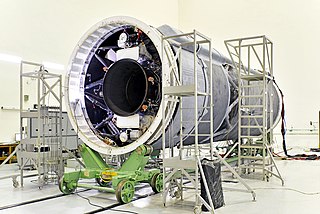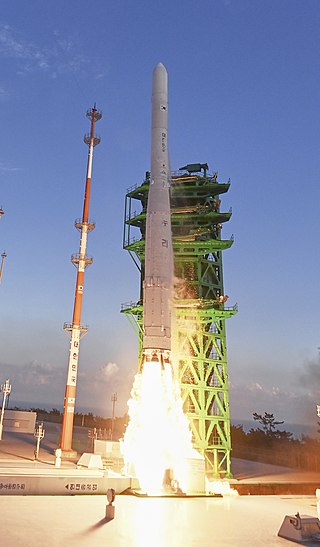
A hybrid-propellant rocket is a rocket with a rocket motor that uses rocket propellants in two different phases: one solid and the other either gas or liquid. The hybrid rocket concept can be traced back to the early 1930s.

A rocket engine uses stored rocket propellants as the reaction mass for forming a high-speed propulsive jet of fluid, usually high-temperature gas. Rocket engines are reaction engines, producing thrust by ejecting mass rearward, in accordance with Newton's third law. Most rocket engines use the combustion of reactive chemicals to supply the necessary energy, but non-combusting forms such as cold gas thrusters and nuclear thermal rockets also exist. Vehicles propelled by rocket engines are commonly used by ballistic missiles and rockets. Rocket vehicles carry their own oxidiser, unlike most combustion engines, so rocket engines can be used in a vacuum to propel spacecraft and ballistic missiles.

A liquid-propellant rocket or liquid rocket utilizes a rocket engine burning liquid propellants. (Alternate approaches use gaseous or solid propellants.) Liquids are desirable propellants because they have reasonably high density and their combustion products have high specific impulse (Isp). This allows the volume of the propellant tanks to be relatively low.

The Aerojet Rocketdyne RS-25, also known as the Space Shuttle Main Engine (SSME), is a liquid-fuel cryogenic rocket engine that was used on NASA's Space Shuttle and is used on the Space Launch System (SLS).

The J-2, commonly known as Rocketdyne J-2, was a liquid-fuel cryogenic rocket engine used on NASA's Saturn IB and Saturn V launch vehicles. Built in the United States by Rocketdyne, the J-2 burned cryogenic liquid hydrogen (LH2) and liquid oxygen (LOX) propellants, with each engine producing 1,033.1 kN (232,250 lbf) of thrust in vacuum. The engine's preliminary design dates back to recommendations of the 1959 Silverstein Committee. Rocketdyne won approval to develop the J-2 in June 1960 and the first flight, AS-201, occurred on 26 February 1966. The J-2 underwent several minor upgrades over its operational history to improve the engine's performance, with two major upgrade programs, the de Laval nozzle-type J-2S and aerospike-type J-2T, which were cancelled after the conclusion of the Apollo program.

El Arenosillo Test Centre (CEDEA) is the name of a rocket launch site for suborbital rockets managed by INTA, located in Moguer (Spain). It is located in the province of Huelva, Andalucía, in the southwest coast of Spain (37.1° N, 6.7° W). CEDEA is adjacent to the Center of Excellence for Unmanned Systems (CEUS).

The CE-7.5 is a cryogenic rocket engine developed by the Indian Space Research Organisation to power the upper stage of its GSLV Mk-2 launch vehicle. The engine was developed as a part of the Cryogenic Upper Stage Project (CUSP). It replaced the KVD-1 (RD-56) Russian cryogenic engine that powered the upper stage of GSLV Mk-1.
Fastrac was a turbo pump-fed, liquid rocket engine. The engine was designed by NASA as part of the low cost X-34 Reusable Launch Vehicle (RLV) and as part of the Low Cost Booster Technology project. This engine was later known as the MC-1 engine when it was merged into the X-34 project.

Rocket propellant is the reaction mass of a rocket. This reaction mass is ejected at the highest achievable velocity from a rocket engine to produce thrust. The energy required can either come from the propellants themselves, as with a chemical rocket, or from an external source, as with ion engines.

Nuri, also known as KSLV-II, is a three-stage launch vehicle, the second one developed by South Korea and the successor to Naro-1 (KSLV-1). Nuri is developed by Korea Aerospace Research Institute (KARI). All three stages use indigenously developed launch vehicle engines, making Nuri the first indigenously developed South Korean orbital launch vehicle.
Tronador is a series of Argentine rockets, including the Tronador I and Tronador II vehicles, to develop a liquid-propellant rocket expendable launch system called ISCUL.

SuperDraco is a hypergolic propellant rocket engine designed and built by SpaceX. It is part of the SpaceX Draco family of rocket engines. A redundant array of eight SuperDraco engines provides fault-tolerant propulsion for use as a launch escape system for the SpaceX Dragon 2, a passenger-carrying space capsule.

The Blue Engine 4 (BE-4) is an oxygen-rich liquefied-methane-fueled staged-combustion rocket engine produced by Blue Origin. The BE-4 was developed with private and public funding. The engine has been designed to produce 2.4 meganewtons (550,000 lbf) of thrust at sea level.

Zero 2 Infinity is a private Spanish company developing high-altitude balloons intended to provide access to near space and low Earth orbit using a balloon-borne pod and a balloon-borne launcher.

Payload Aerospace S.L. is a Spanish company developing two partially-reusable launch vehicles called Miura 1 and Miura 5.

Rutherford is a liquid-propellant rocket engine designed by aerospace company Rocket Lab and manufactured in Long Beach, California. The engine is used on the company's own rocket, Electron. It uses LOX and RP-1 as its propellants and is the first flight-ready engine to use the electric-pump feed cycle. The rocket uses a similar engine arrangement to the Falcon 9; a two-stage rocket using a cluster of nine identical engines on the first stage, and one vacuum-optimized version with a longer nozzle on the second stage. This arrangement is also known as an octaweb. The sea-level version produces 24.9 kN (5,600 lbf) of thrust and has a specific impulse of 311 s (3.05 km/s), while the vacuum optimized-version produces 25.8 kN (5,800 lbf) of thrust and has a specific impulse of 343 s (3.36 km/s).

Miura 1 is a suborbital recoverable launch vehicle developed by the Spanish company PLD Space. It is planned to be the first recoverable launch vehicle in Europe. It was first launched successfully on October 7, 2023, at 00:19 UTC.

Miura 5 is a two-stage European orbital recoverable launch vehicle currently under development by the Spanish company PLD Space. In a standard two-stage configuration, it will have a length of 34 m, be capable of inserting 1000 kg of payload into a low Earth orbit (LEO), featuring an optional kick stage that can circularize the orbits of satellites.

Raptor is a family of rocket engines developed and manufactured by SpaceX. The engine is a full-flow staged combustion cycle (FFSC) engine powered by cryogenic liquid methane and liquid oxygen ("methalox").
The Vikram is a family of small-lift launch vehicles being developed by Skyroot Aerospace, an Indian startup aerospace company.


















